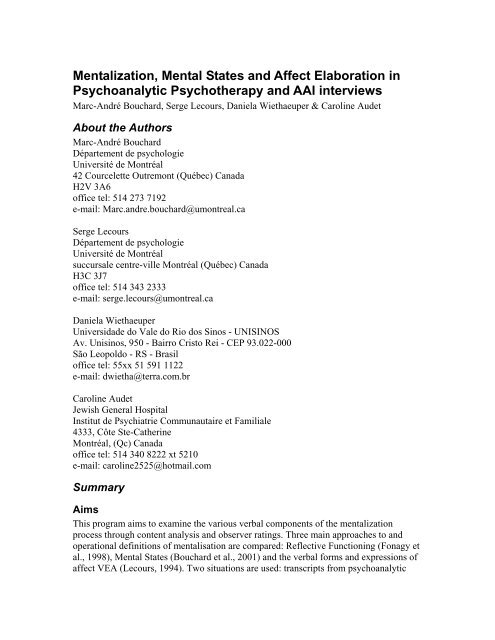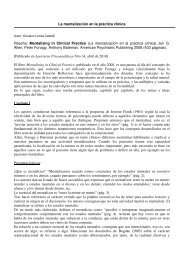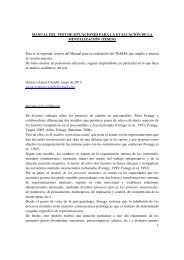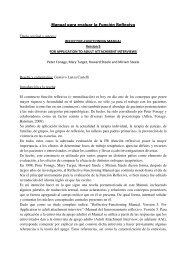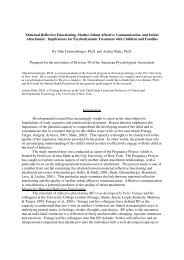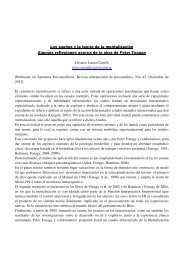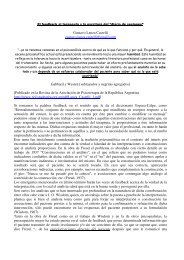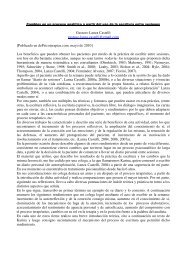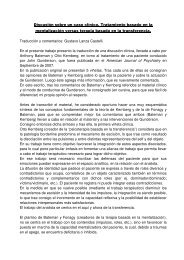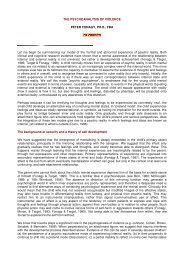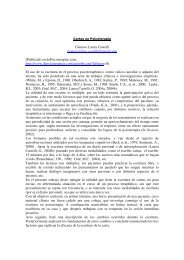Mentalization, Mental States and Affect Elaboration - mentalizacion y ...
Mentalization, Mental States and Affect Elaboration - mentalizacion y ...
Mentalization, Mental States and Affect Elaboration - mentalizacion y ...
Create successful ePaper yourself
Turn your PDF publications into a flip-book with our unique Google optimized e-Paper software.
<strong><strong>Mental</strong>ization</strong>, <strong>Mental</strong> <strong>States</strong> <strong>and</strong> <strong>Affect</strong> <strong>Elaboration</strong> in<br />
Psychoanalytic Psychotherapy <strong>and</strong> AAI interviews<br />
Marc-André Bouchard, Serge Lecours, Daniela Wiethaeuper & Caroline Audet<br />
About the Authors<br />
Marc-André Bouchard<br />
Département de psychologie<br />
Université de Montréal<br />
42 Courcelette Outremont (Québec) Canada<br />
H2V 3A6<br />
office tel: 514 273 7192<br />
e-mail: Marc.<strong>and</strong>re.bouchard@umontreal.ca<br />
Serge Lecours<br />
Département de psychologie<br />
Université de Montréal<br />
succursale centre-ville Montréal (Québec) Canada<br />
H3C 3J7<br />
office tel: 514 343 2333<br />
e-mail: serge.lecours@umontreal.ca<br />
Daniela Wiethaeuper<br />
Universidade do Vale do Rio dos Sinos - UNISINOS<br />
Av. Unisinos, 950 - Bairro Cristo Rei - CEP 93.022-000<br />
São Leopoldo - RS - Brasil<br />
office tel: 55xx 51 591 1122<br />
e-mail: dwietha@terra.com.br<br />
Caroline Audet<br />
Jewish General Hospital<br />
Institut de Psychiatrie Communautaire et Familiale<br />
4333, Côte Ste-Catherine<br />
Montréal, (Qc) Canada<br />
office tel: 514 340 8222 xt 5210<br />
e-mail: caroline2525@hotmail.com<br />
Summary<br />
Aims<br />
This program aims to examine the various verbal components of the mentalization<br />
process through content analysis <strong>and</strong> observer ratings. Three main approaches to <strong>and</strong><br />
operational definitions of mentalisation are compared: Reflective Functioning (Fonagy et<br />
al., 1998), <strong>Mental</strong> <strong>States</strong> (Bouchard et al., 2001) <strong>and</strong> the verbal forms <strong>and</strong> expressions of<br />
affect VEA (Lecours, 1994). Two situations are used: transcripts from psychoanalytic
psychotherapy sessions, <strong>and</strong> Adult Attachment Interviews (AAIs) from a variety of<br />
normal <strong>and</strong> psychopathological conditions.<br />
Methods<br />
Psychotherapy sessions <strong>and</strong> AAI interviews are transcribed. Independent observers,<br />
trained in the use of detailed manuals, rate these sessions through various scoring<br />
systems. These measures are then compared <strong>and</strong> contrasted, either with outcome<br />
measures, other psychotherapy process measures, diagnostic information <strong>and</strong> the AAI<br />
classification. The statistical approach is correlational, using regression analysis.<br />
Results<br />
Component study 1 (see below): Comparing two psychoanalytic psychotherapy<br />
beginnings (two series of n=14 sessions), offered by the same analyst, one a premature<br />
termination case, the other leading to a positive outcome, it was possible<br />
A) to differentiate between positive <strong>and</strong> negative transference-countertransference cycles,<br />
based on a determination of each participant's mental state (mostly reactive versus mostly<br />
reflective)<br />
B) to indicate further that in the premature termination case, a culmination of a negative<br />
cycle of projection <strong>and</strong> reintrojection occurred, around session 7, which led to the<br />
patient's decision to bring her therapy to an end<br />
C) Based on Liberman's description of patient <strong>and</strong> analyst linguistic styles (Liberman,<br />
1983), <strong>and</strong> their positive (complementary) versus negative (concordant) sequences an<br />
operational definition was developed <strong>and</strong> applied to the two series of sessions<br />
(Wiethaeuper, 1999). Negative (concordant) sequences were negatively related to<br />
independent ratings of helpfulness. More positive interactions were found in the<br />
successful compared to the premature termination case<br />
Component study 2 (see below): Findings indicate some good convergence between the<br />
various measures of mentalisation, with some specific differential relationships for each<br />
component as predictors of attachment status or the presence of a personality disorder<br />
(PD). Reflective Function is uniquely predictive of attachment status. Increments in<br />
affect elaboration, the predominance of a reflective mental state or high levels of<br />
defensive activity during the AAI interview are associated with a reduced likelihood of a<br />
subject suffering from a PD.<br />
References<br />
Bouchard, M. A., Audet, C., Picard, C., Carrier, M., & Milcent, M. P. (2001). The <strong>Mental</strong><br />
<strong>States</strong> Rating System. Scoring Manual.Unpublished manuscript, Université de Montréal,<br />
Canada.<br />
Fonagy, P., Target, M., Steele, H., & Steele, M. (1998). Reflective-Functioning Manual,<br />
version 5.0, for Application to Adult Attachment Interviews. London: University College<br />
London.<br />
Lecours, S. (1994). Manuel de cotation de la Grille de l’ Élaboration Verbale de l’<strong>Affect</strong><br />
(GÉVA). Rating Manual. Université de Montréal.
Liberman, D. (1983). Linguistica, interaccion communicative y processo psicoanalitico.<br />
Tomos I y II. Buenos Aires: Kargieman.
Component Study 1: An Empirical Study of a Successful <strong>and</strong><br />
Unsuccessful Psychotherapeutic Process: Positive <strong>and</strong> Negative<br />
Transference-Countertransference Cycles <strong>and</strong> Complementarity<br />
in Linguistic Styles<br />
Aims<br />
To further our underst<strong>and</strong>ing of the interactive cycles of transference <strong>and</strong><br />
countertransference projection <strong>and</strong> re-introjection by testing an operational differentiation<br />
of mental states <strong>and</strong> linguistic style, using two instruments: the MTCM (Montreal<br />
Transference Countertransference Measure; Bouchard et al., 2001) <strong>and</strong> its associated<br />
PNRC (Audet, 2001), <strong>and</strong> the LLSM (Liberman Linguistic Styles Measure, Wiethaeuper,<br />
1999) based on concepts of interactive communication proposed by D. Liberman (1983).<br />
Methods<br />
The clinical material is of a male experienced psychoanalyst meeting two patients for an<br />
open-ended trial of psychoanalytic psychotherapy, twice a week, face to face (patients A<br />
<strong>and</strong> B). Patient A prematurely interrupted her therapy after 14 sessions <strong>and</strong> is considered<br />
a failure; patient B moved on to a successful outcome for a total of 234 sessions. It was<br />
decided to compare <strong>and</strong> contrast the first 14 sessions from each pair. In addition the<br />
Defense Mechanisms Rating Scales (Perry, 1993) was also coded for all sessions.<br />
Within the MTCM transference is construed within an object-relations framework, with a<br />
consideration of three manifest situations (transferential, extra-transferential <strong>and</strong> past), an<br />
indication of displacements <strong>and</strong> allusions (Gill, 1979), <strong>and</strong> finally of defensive turning of<br />
aggression against the self (Gray, 1994). Countertransference includes independent<br />
ratings of (a) the therapist's interpretative focus (transferential or not, awareness or<br />
resolution, etc.); (b) the degree of inference (clarification, direct opinion, confrontation<br />
<strong>and</strong> interpretation); (c) a differentiation between three in-session mental states: objectiverational,<br />
reactive <strong>and</strong> reflective (Norm<strong>and</strong>in, 1991; Norm<strong>and</strong>in & Bouchard, 1993).<br />
Positive <strong>and</strong> negative relationship configurations (PNRC, Audet, 2001) were defined. To<br />
represent the present state of the relationship, being specified as either negative, positive<br />
or neutral. Configurations are identified based on both participant's mental states<br />
(reflective, reactive, objective-rational) <strong>and</strong> on the confirmation or disconfirmation of the<br />
patient's projected relational scenarios within the interaction.<br />
The LLSM contains a detailed presentation of Liberman's six linguistic styles (Liberman,<br />
1983): a) Reflexive who searches for the unknown (incognito) <strong>and</strong> does not create<br />
suspense (non-participant observer); b) Lyrical c) Epic (action, or pragmatic aspect) d)<br />
Narrative (Logic) e) Dramatic style with suspense (the frightened person who uses the<br />
dramatization, <strong>and</strong> appeals to verbal incognitos) f) Dramatic style with aesthetic impact<br />
(theatrical, demonstrative). In addition, the LLSM included a description of a Concrete<br />
style. See below for more information on the LLSM.
Results<br />
The two psychotherapy beginnings examined have followed two very distinct courses. As<br />
hypothesized, case A presents more negative than positive PNRC configurations, in<br />
contrast to case B. More positive <strong>and</strong> less neutral LLSM linguistic patterns were found in<br />
pair B; negative interactions were negatively correlated with independent session ratings<br />
of helpfulness by experienced clinicians. So-called "neutral" interactions seemed<br />
indicative of moments of resistance, <strong>and</strong> were related to specificities in the defensivecharacterological<br />
functioning of each patient.<br />
Conclusions<br />
It is possible to discriminate between positive <strong>and</strong> negative transferencecountertransference<br />
cycles, based on three criteria: participant's mental states,<br />
confirmation or disconfirmation of projections, linguistic styles. These configurations are<br />
related to outcome.<br />
References<br />
Audet, C. (2001). MTCM's Second Level of Analysis: The Positive <strong>and</strong> Negative<br />
Relationship Configurations (PNRC). Version 3.1, July 2001.Unpublished manuscript,<br />
Université de Montréal, Canada.<br />
Bouchard, M. A., Audet, C., Picard, C., Carrier, M., & Milcent, M. P. (2001). The <strong>Mental</strong><br />
<strong>States</strong> Rating System. Scoring Manual.Unpublished manuscript, Université de Montréal,<br />
Canada.<br />
Gill, M. M. (1979). The analysis of the transference. Journal of the American<br />
Psychoanalytic Association, 27, Suppl.:263-288<br />
Gray, P. (1994). The Ego <strong>and</strong> Analysis of Defense. Northvale, NJ: Aronson.<br />
Liberman, D. (1983). Linguistica, interaccion communicative y processo psicoanalitico.<br />
Tomos I y II. Buenos Aires : Kargieman.<br />
Norm<strong>and</strong>in, L. (1991). La réflexivité dans la construction de l'espace thérapeutique.<br />
September 1991. Unpublished Doctoral Dissertation, Université de Montréal.<br />
Norm<strong>and</strong>in, L. & Bouchard, M.A. (1993). The Effects of Theoretical Orientation <strong>and</strong><br />
Experience on Rational, Reactive <strong>and</strong> Reflective Countertransference. Psychotherapy<br />
Research, 3, 77-94.<br />
Perry, J.C. (1993). Defenses <strong>and</strong> their effects. In N.E. Miller, L. Luborsky, J.P. Barber, &<br />
J.P. Docherty (Eds.). Psychodynamic treatment research (pp. 274-306). New York :<br />
Basic Books.
The Liberman Linguistic Styles Measure (LLSM)<br />
Styles Patient’s styles <strong>and</strong> analyst’s<br />
complementary responses<br />
1.<br />
Dramatic<br />
Aesthetic<br />
Theatrical<br />
2.<br />
Dramatic<br />
Suspense<br />
This demonstrative mode fascinates by<br />
the richness of expression. Metaphors,<br />
hyperboles, plastic images <strong>and</strong><br />
symbolism abound. Symbols of facts<br />
are used as if they were the facts<br />
themselves. The discourse may be<br />
equated to a dream. Castration anxiety<br />
is managed through projection,<br />
dramatization <strong>and</strong> the creation of an<br />
aesthetic impact. The subject tells<br />
stories that continually intend to<br />
captivate the attention. The listener<br />
becomes an observer of a dramatic<br />
scene, which seems to be happening<br />
right now. Here the analys<strong>and</strong><br />
defends against painful affects by<br />
becoming a seductive raconteur<br />
Analyst’ s complementary style. The<br />
schizoid- reflective attitude helps the<br />
analyst to perceive <strong>and</strong> put into abstract<br />
words the patients’ autoplastic,<br />
dramatized activity, <strong>and</strong> his dissociated<br />
or inhibited “mute parts”. Moving away<br />
from being a captive spectator, the<br />
reflective function invites the patient to<br />
reflectively observe his inner mental<br />
scene.<br />
This style has the worst syntax.<br />
Sentences are interrupted in the middle<br />
in an attempt to repress certain themes,<br />
as a result of a manifest phobic anxiety.<br />
The first person (I) pronoun is avoided.<br />
The effect on the listener is one of<br />
confusion, misunderst<strong>and</strong>ing <strong>and</strong><br />
obscurity. This can be reversed when<br />
patients are able to get in touch with<br />
their repressed unconscious wishes.<br />
This generates new symbolic meanings<br />
in phrases with optimal syntax.<br />
Analyst’s style (<strong>and</strong><br />
countertransference) as<br />
expressed in the analytic<br />
situation<br />
The dramatic aesthetic analyst<br />
names the patients’ internal<br />
contents in a symbolic <strong>and</strong><br />
imagistic manner, linking the<br />
affect <strong>and</strong> the representation.<br />
Interventions are rich in visual<br />
<strong>and</strong> plastic contents. Some<br />
exhibitionistic wishes may be<br />
gratified. Within an oedipal<br />
transference countertransference<br />
situation, the analyst’s<br />
seductiveness <strong>and</strong> its impact on<br />
the patient may be lost to the<br />
analyst’s observing ego.<br />
The phobic (dramatic suspense)<br />
analyst may avoid making<br />
transference interpretations when<br />
these involve themes which<br />
activate unconscious fantasies<br />
generating conflict <strong>and</strong> anxiety<br />
within the countertransference.<br />
Long, ambiguous sentences<br />
containing several interpolated<br />
clauses which leaves unclear<br />
which is the most important<br />
phrase are observed. The patients’
3.<br />
Narrative<br />
Analyst’s complementary style. The<br />
patient is avoiding endopsychic<br />
contents. Again the analyst’s reflectiveschizoid<br />
capacities help bring the focus<br />
back on intrapsychic activity, finding<br />
appropriate words <strong>and</strong> meanings.<br />
Formal logic <strong>and</strong> perfect syntax are<br />
used to supersede the logic of emotions.<br />
This style concentrates on the<br />
semantics, while ignoring the pragmatic<br />
implications, or the effect the discourse<br />
has on others. Decision <strong>and</strong> action often<br />
fall short of being completed. Sentences<br />
make a frequent usage of associations<br />
by temporal or spatial proximity or by<br />
similarities. The subject is excessively<br />
preoccupied with controlling the way<br />
others underst<strong>and</strong> him <strong>and</strong> the way they<br />
must talk. Narration is sequential,<br />
images <strong>and</strong> dramatic aspects are absent.<br />
The listener feels little ‘room” to<br />
fantasize or to create a plastic image of<br />
the narration. Example: A patient who<br />
feels injured after being passed over for<br />
promotion by a “friendly” boss decries<br />
the lack of “loyalty” of said boss<br />
regardless of the context. The analyst<br />
while seeing the patient’s point of view<br />
might feel controlled, almost afraid to<br />
question the patient on his “letter of the<br />
law” style.<br />
Analyst’s complementary style. The<br />
patient’s narrative self imprisonment<br />
can be usefully met by the epic modes<br />
of communication, whereby the<br />
pragmatic impact is underlined. Actions<br />
in words are used to free the patient<br />
from endless <strong>and</strong> controlling discourse.<br />
The intent often is to demonstrate to the<br />
patient how he limits <strong>and</strong> controls the<br />
communicative experience <strong>and</strong> how he<br />
thereby attempts to prevent any<br />
unexpected reactions (i.e. feelings of<br />
chaos <strong>and</strong> uncertainty; see illustration<br />
requests for clarifications are<br />
answered in a tangential manner.<br />
Phrases may be stopped in the<br />
middle, leaving it to the patient<br />
to complete them. Questions are<br />
unclear <strong>and</strong> incomplete, creating<br />
a “suspense” effect.<br />
There is an emphasis on formal<br />
logic <strong>and</strong> on the correctness of the<br />
syntax. The analyst is meticulous<br />
in describing situations <strong>and</strong><br />
opinions. But also, questions about<br />
facts may create an impression of a<br />
court hearing where responses are<br />
limited to “yes” or “no”.<br />
On occasion, the narrative analyst<br />
may instrumentally emphasize self<br />
<strong>and</strong> object differentiation by<br />
underlining the “you” versus “I”<br />
components of speech. This is<br />
useful for instance in response to<br />
the lyric mode.
4. Epic<br />
in body of text).<br />
The pragmatic implications of language<br />
that stimulate action are used to<br />
threaten the shared, manifest<br />
therapeutic aim <strong>and</strong> thus break the<br />
common semantic space. The discourse<br />
is not so much used to communicate<br />
something, as to hide, to control or to<br />
indirectly convince the listener about<br />
something. The intended impact on the<br />
interlocutor is implicit. The epic subject<br />
attempts to inoculate others with his<br />
wishes. Thinking is a major difficulty,<br />
<strong>and</strong> symbols are not used to elaborate<br />
the inner thought. Instead, scenarios<br />
<strong>and</strong> characters are continually changed<br />
so that it becomes impossible to<br />
underst<strong>and</strong> the symbolic contents of<br />
their discourse. The characters in the<br />
stories are usually very “crude” as they<br />
often represent primitive partial object<br />
relations. A borderline patient who is a<br />
student may come into a session<br />
insisting on the analyst’s help with a<br />
paper, then spend the entire session<br />
describing himself as an undiscovered<br />
genius. Threats are made to interrupt<br />
the session so as to tell this to his<br />
professor. The epic pathological<br />
variant is an action-oriented style often<br />
based on “gr<strong>and</strong> gestures”.<br />
Analyst’s complementary style. The<br />
analyst must express in narrative form<br />
the effects the patients’ words <strong>and</strong><br />
implied actions have on others,<br />
including himself. This may bring some<br />
order to the chaos of the patients’<br />
projective identifications. This may<br />
also indicate how a more profitable<br />
dialogue might be possible, thus hoping<br />
to partake once again into a shared<br />
semantic space (see illustration in body<br />
The epic analyst will often impact<br />
the discourse using one or another<br />
modality, which induces a<br />
response: questioning,<br />
underlining, countering, etc. This<br />
may refocus the analytic dialogue<br />
on a salutary, completely<br />
different mode (see text for<br />
illustration).<br />
Alternately, the epic analyst may<br />
inappropriately induce the patient<br />
to feel things he is not prepared to<br />
experience. He may then lose his<br />
capacity to think. As a result of a<br />
countertransference reaction, this<br />
in fact becomes a verbal<br />
enactment. He may interrupt the<br />
patients’ speech, become angry or<br />
seductive, etc.
5. Lyric<br />
6.<br />
Schizoid-<br />
Reflective<br />
of text).<br />
Within the lyrical style, words <strong>and</strong><br />
affects associated with words are<br />
condensed, such that the patient is<br />
overwhelmed with emotions. A<br />
culpability <strong>and</strong> preoccupation with<br />
causes of behaviours <strong>and</strong> situations is<br />
apparent. It may seem like the patient<br />
shares his insights, but the emotional<br />
expression is actually a complaint. This<br />
is a consequence of projecting the guilt<br />
(responsibility) or turning it against<br />
themselves. Their listening is under the<br />
pressures of the avid, oral-cannibalistic<br />
drive. As a consequence they lose the<br />
capacity to differentiate between the<br />
self <strong>and</strong> others. The analyst is also seen<br />
as someone who must regulate their<br />
self-esteem <strong>and</strong> respond to counteract<br />
their inner hostile superego. A semantic<br />
distortion of the messages is<br />
consequently apparent, as when<br />
interpretations are understood<br />
selectively as a proof or lack thereof, of<br />
the analysts’ benevolent feelings.<br />
Analyst’s complementary style. The<br />
analyst must attempt, using a narrative<br />
form, to differentiate himself from the<br />
patient’s projected responsibilities <strong>and</strong><br />
superego pressures. He may then rescue<br />
his own identity, helping the patient to<br />
tolerate the impact of separation <strong>and</strong><br />
aloneness, without falling prey to<br />
excessive inner depressive <strong>and</strong><br />
superego attacks.<br />
In this reflective-schizoid position the<br />
subject observes from a distance,<br />
abstracting <strong>and</strong> generalizing, in a<br />
detached, non participating mode. The<br />
affective <strong>and</strong> motor functions are<br />
dissociated. Thoughts are invested,<br />
rather than emotions <strong>and</strong> emotional<br />
The lyric analyst is often dealing<br />
with his own projected inner<br />
objects. He may be either very<br />
critical or feel criticized by the<br />
patient. As result of a<br />
countertransference response he<br />
may actively attempt to find ways<br />
to appease anticipatory negative<br />
consequences resulting from<br />
conflicts with his own superego,<br />
as perceived in the patient’s<br />
dem<strong>and</strong>s. He may attempt to<br />
pacify the patients’ dem<strong>and</strong>s for<br />
love <strong>and</strong> through inappropriate<br />
reassurances <strong>and</strong><br />
encouragements. Attention <strong>and</strong><br />
admiration is inappropriately<br />
sought by the analyst.<br />
The “schizoid-reflective” analyst<br />
uses detachment to observe,<br />
abstract <strong>and</strong> put words to inner<br />
endopsychic contents that are<br />
avoided by the patient.<br />
Interpretive questions also<br />
illustrate this style in the analyst.
connections with others. The discourse<br />
is markedly philosophic <strong>and</strong> abstract.<br />
Emotional situations <strong>and</strong> important<br />
facts of life are described as if part of a<br />
scientific documentary. Language can<br />
be cryptic, neologisms may appear. The<br />
detachment is more structural than<br />
defensive. The syntax is good. The<br />
subject is usually under a pragmatic<br />
impact creating distrust or disbelief. He<br />
responds by being impersonal. To the<br />
extreme, the patient may sound like a<br />
“talking dictionary”.<br />
Analyst’s complementary style. A<br />
dramatic aesthetic style typically links<br />
representation <strong>and</strong> affect, using<br />
symbols <strong>and</strong> images to create an<br />
immediate impact, which tends to get<br />
the listener to experience more<br />
affective involvement.<br />
Such minor dissociation makes<br />
possible to keep facts <strong>and</strong><br />
situations vivid in our memory.<br />
Silence <strong>and</strong> withdrawal can be<br />
used as a defense <strong>and</strong> protective<br />
position against the transferential<br />
pressures. It may become an<br />
important “refuge” in order to<br />
find a better way to interpret the<br />
patients’ conflicts.
Component Study 2: <strong><strong>Mental</strong>ization</strong> in Adult Attachment :<br />
Reflective Functioning, <strong>Mental</strong> <strong>States</strong> <strong>and</strong> <strong>Affect</strong> <strong>Elaboration</strong><br />
Compared<br />
Aims<br />
To compare three related measures of the mental elaboration process : <strong>Mental</strong> <strong>States</strong> (one<br />
key dimension from the MTCM, Bouchard et al., 2001), the Verbal <strong>Elaboration</strong> of <strong>Affect</strong><br />
(VEA) as an aspect of mentalisation that refers to the transformation of drive-affect<br />
experiences (Lecours, 1994) <strong>and</strong> Reflective Functioning (Fonagy, Target, Steele &<br />
Steele, 1998) which measures the clarity of a person's representation of mental states,<br />
whether of self or others.<br />
Methods<br />
73 non-clinical adult volunteers <strong>and</strong> ex-psychiatric patients were administered the Adult<br />
Attachment Interview (AAI). Transcripts were independently rated using the GEVA<br />
(Lecours, 1994; Lecours, Bouchard et al., 2000; see below for more information on the<br />
GEVA), the MSRS (<strong>Mental</strong> <strong>States</strong> Rating System, Bouchard et al., 2001; see below for<br />
more information on the MSRS) <strong>and</strong> the Reflective Function Scale (Fonagy et al., 1998).<br />
The GEVA (Grille de l'<strong>Elaboration</strong> Verbale de l'<strong>Affect</strong>, measures the formal properties of<br />
VEA, defined as levels of affect elaboration according to two dimensions: 1) four<br />
channels of verbal expression: somatic <strong>and</strong> motor activity, imagery <strong>and</strong> labeling<br />
verbalization; 2) five levels of affect tolerance/abstraction: disruptive impulsion,<br />
modulated impulsion, externalization, appropriation <strong>and</strong> meaning association). These<br />
jointly specify 20 (4 channels X 5 levels) different forms, so that each verbal expression<br />
of an affect receives one of these 20 individual scores. The 20 basic categories can be<br />
combined in various ways to produce supraordinate global categories or basic<br />
dimensional scales.<br />
Results<br />
Attachment status <strong>and</strong> the presence or absence of an Axis I <strong>and</strong> an Axis II diagnosis were<br />
examined. Reflective function was the only predictor of attachment status. Attachment<br />
security was highly predictive of a reduced likelihood of an Axis I diagnosis.<br />
Increments in affect elaboration, as well as augmentations in high-level defensive activity<br />
<strong>and</strong> reflective function all increase the odds of a subject not receiving an Axis II<br />
diagnosis.<br />
References<br />
Bouchard, M. A., Audet, C., Picard, C., Carrier, M., & Milcent, M. P. (2001). The <strong>Mental</strong><br />
<strong>States</strong> Rating System. Scoring Manual.Unpublished manuscript, Université de Montréal,<br />
Canada.
Fonagy, P., Target, M., Steele, H., & Steele, M. (1998). Reflective-Functioning Manual,<br />
version 5.0, for Application to Adult Attachment Interviews. London: University College<br />
London.<br />
Lecours, S. (1994). Manuel de cotation de la Grille de l’ Élaboration Verbale de l’<strong>Affect</strong><br />
(GÉVA). Rating Manual. Université de Montréal.<br />
The Grille de l'<strong>Elaboration</strong> Verbale de l'<strong>Affect</strong> (GEVA): A Short<br />
Introduction<br />
This text is adapted from Lecours, 1994. Please contact Serge Lecours for more<br />
information about the GEVA.<br />
We have proposed a descriptive model of a particular component of mentalisation,<br />
centered around the notion of Verbal <strong>Elaboration</strong> of <strong>Affect</strong> (VEA: Lecours & Bouchard,<br />
1997). The GEVA (Grille de l'<strong>Elaboration</strong> Verbale de l'<strong>Affect</strong>, French for verbal<br />
elaboration of affect scale) is a measure of VEA for use in text-analytic methodologies,<br />
which consists of two orthogonal dimensions, in order of increasing mentalisation: four<br />
channels of affect expression (somatic <strong>and</strong> motor activity, imagery <strong>and</strong> labeling<br />
verbalization) <strong>and</strong> five levels of affect tolerance <strong>and</strong> abstraction (disruptive impulsion,<br />
modulated impulsion, externalization, appropriation, meaning association). These jointly<br />
specify 20 (4 channels X 5 levels) different forms, so that each verbal expression of an<br />
affect receives one of these 20 individual scores. The 20 basic categories can be<br />
combined in various ways to produce supraordinate global categories or basic<br />
dimensional scales.<br />
We turn now to a description of the channels of expression. A patient who reports a<br />
sudden nausea or headache uses the somatic channel, <strong>and</strong> indirectly expresses an affect<br />
through the verbalization of an internal physiological sensation: here the autonomic<br />
internal body is "talking". The motor channel involves a reference to a specific behavior,<br />
which may include manifestations of the muscular external body (i.e. "I got drunk <strong>and</strong> hit<br />
my wife") or, at a high level of containment, more abstract behavioral attitudes (i.e. "At<br />
first I was hostile to my wife"). Metaphors, fantasies or dreams are often used to<br />
communicate affects through the imagery modality. Within the imagery channel, at a<br />
lower level of containment one may get such expressions as: "I see myself stabbing my<br />
child with a knife", up to a more appropriated: "I felt I was about to explode". Through<br />
the verbalization channel, the affect is expressed by means of direct labels, which use<br />
common social language. With lower containment we have the patient who impulsively<br />
repeats to coworkers, almost screaming, that his boss is an "abusive dumbfuck", <strong>and</strong> loses<br />
his job, in contrast to a more contained verbal form taken by another, female employee,<br />
who successfully <strong>and</strong> assertively confronts the management team concerning some<br />
potentially abusive new administrative measure.<br />
The tolerance/abstraction dimension then is specified as follows in five levels. 1)<br />
Disruptive impulsion: the affect is not tolerated, instead it is directly discharged <strong>and</strong><br />
evacuated, no reflective distance is presently effective. The subject doesn't talk about the<br />
affect, rather he expels it while talking, <strong>and</strong> his awareness is minimal or completely
absent. This level corresponds to the familiar notion of acting out. 2) Modulated<br />
impulsion: the affect is still expelled, <strong>and</strong> not reflected upon. The expression is indirect<br />
but is here more modulated. This level is part of a healthy spontaneity <strong>and</strong> gratification. It<br />
is a required condition for instance of sexual pleasure, of laughing or crying, etc. A<br />
subject who is impatient <strong>and</strong> tense, interjects: "She is late again, <strong>and</strong> we're on in five<br />
minutes..." Another person uses the imagery mode to express her anxiety: "I was shaking<br />
like a leaf". 3) Externalization: the affect is now more mentalised as it is recognized as a<br />
subjective experience, but is perceived as if caused by an external event, or disowned by<br />
generalization. An externalized frustration, via a reference to the motor channel is seen in<br />
the following: "The children agitate me". 4) Appropriation: the affect is fully tolerated<br />
<strong>and</strong> felt as an internal, private, subjective experience. It is labelled <strong>and</strong> owned,<br />
appropriated by the subject. These are the more explicit forms of affect expression: "I felt<br />
ready to explode" (imagery); "I am frustrated right now" (verbal). 5) Meaning<br />
association: the affect, appropriated, is further endowed with a fuller meaning through a<br />
complexification <strong>and</strong> enrichment of associations, resulting in a clearer knowledge: "I was<br />
hostile then, to avoid being dependent".<br />
The <strong>Mental</strong> <strong>States</strong> Rating System (MSRS): Summary of Criteria<br />
MSRS Dimensional Rating: Version 5.4<br />
This is a complement to the <strong>Mental</strong> <strong>States</strong> Rating System (MSRS-Manual, version 4.1),<br />
by Bouchard, Audet, Picard, Carrier & Milcent, 2001. The MSRS is itself a part of the<br />
larger MTCM process measure. The initial distinctions are contained in Norm<strong>and</strong>in<br />
(1991) <strong>and</strong> Norm<strong>and</strong>in <strong>and</strong> Bouchard (1993). Correspondence may be addressed to Marc-<br />
André Bouchard.<br />
Objective-rational mental state<br />
1. Predominant focus on objective facts <strong>and</strong> situations. On public, general,<br />
observable <strong>and</strong> objective dimensions of life events, present situation, or<br />
emerging memory. Different from simple presence.<br />
2. Relative absence of emotional <strong>and</strong> affective elements in the patient's<br />
discourse (not due to isolation, repression <strong>and</strong> the like). Paralinguistic<br />
elements, prosody, non-verbal elements not considered as affective elements.<br />
3. The subject is not focused on the emotional, private, intrapsychic <strong>and</strong><br />
subjective domain. If attention is put on emotional, private, intrapsychic or<br />
subjective matters, it is as if these were a thing observed from a distance.<br />
Concrete thinking at a non-psychotic level<br />
A reality-oriented ego displaying a logico-grammatical structure is available. However,<br />
the ego’s organizing <strong>and</strong> reflecting capacities are presently lost <strong>and</strong> inaccessible, or may<br />
never have fully developed. Thoughts <strong>and</strong> memories are experienced in the form of<br />
immediate, non-psychotic sensori-motor, concrete experiences.
1. Associations from one topic to another are concrete, tangential. This is seen in<br />
material, narrow, factual reporting, the presence of anecdotal (even if specific)<br />
<strong>and</strong>/or circumstantial affirmations, that appear as psychologically “meaningless”,<br />
pointless. Such concreteness may serve the subject as a protective device or attack<br />
against unbearable meaning <strong>and</strong> linking.<br />
2. Thoughts <strong>and</strong> memories are generally not consciously related to one another<br />
within a coherent framework. Discourse excludes any<br />
associative/symbolic/abstract connections. If present, connections do not seem<br />
to move much beyond the sensori-motor world. The material only refers to itself.<br />
Words reduplicate action. Thinking is utilitarian. It is at best structured as a<br />
sequential system of facts, of iterative actions-reactions, of concrete quotes<br />
<strong>and</strong> actions.<br />
3. Thoughts <strong>and</strong> memories are isolated, fragmented. Each appears to exist in an<br />
isl<strong>and</strong>.<br />
4. There is no temporal structure to bind together, to establish interrelationships<br />
between thoughts/memories, or with other temporal modes (of what precedes, of<br />
what might follow). Context is not used to create meaning. The notion of a past<br />
that might be repeated is absent.<br />
5. Stereotyped expressions, "clichés", conformism.<br />
6. Non contactful quality ("white relationship"). Empty presence that lacks<br />
reference to inner, alive object or self. Not due to isolation, repression <strong>and</strong> the<br />
like.<br />
Concrete thinking at the psychotic level<br />
A reality-oriented, organizing <strong>and</strong> reflecting ego is essentially lacking. The logicogrammatical<br />
structure has typically fallen apart. Thoughts <strong>and</strong> memories are experienced<br />
in the form of immediate, psychotic sensori-motor, concrete experiences.<br />
1. Subject is not consciously aware of the fact that he/she is remembering things.<br />
2. Associations are endlessly, compulsively, repetitive.<br />
3. Thought processes are not experienced as voluntarily directed, intentional.<br />
4. Past <strong>and</strong> present are equivalent.<br />
5. <strong>Mental</strong> states are experienced via concretized metaphors, the result of symbolic<br />
equations . e.g. <strong>Mental</strong> instability <strong>and</strong> vulnerability is equated with concrete,<br />
physical experiences of falling/needing assistance.<br />
Reflective mental orientation<br />
1. Involved in subjective perception of self or other. Demonstrated capacity to<br />
perceive <strong>and</strong> refer in some verbal form to inner, private experience or reaction,<br />
attributed to either self, other or both.<br />
2. The inner private experience or reaction that is attributed to either self, other or<br />
both is appreciated fully <strong>and</strong> in depth (continuity, clarity, number of different<br />
elements, complexity).
3. Demonstrated awareness of the subjective nature of aspects of the presently<br />
activated experience (during the AAI interview <strong>and</strong>/or past experiences, <strong>and</strong>/or<br />
contemporary external experiences).<br />
4. <strong>Mental</strong> states (of self, other or both) are verbally expressed <strong>and</strong>/or acknowledged.<br />
They help to organize the material.<br />
5. The discourse is fluid. Shows a free/open/spontaneous/contained form of<br />
expression. And it serves one basic purpose : i.e. to increase level of subjective<br />
risk, subjective truth. The process is active, “full <strong>and</strong> alive”.<br />
6. The subject’s intentional orientation is active, effortful, looking-seeking for<br />
mental contents, reason to further self exploration <strong>and</strong> underst<strong>and</strong>ing (irrespective<br />
of degree achieved in emergence, immersion or elaboration).<br />
7. If discourse contains references to or expressions of feelings experienced by self,<br />
other, or both, these have been mentally elaborated from more primitive affects to<br />
toned down, differentiated emotions, which can be identified, as clear <strong>and</strong><br />
distinct. Feelings <strong>and</strong> affects are appropriated (felt to be internal, private,<br />
subjective).<br />
8. The subject’s mental vision of self or other’s experience is clear <strong>and</strong> easy to<br />
grasp. This facilitates one’s emotional, subjective responding to <strong>and</strong> connection<br />
with the experience via empathy, trial identification, possible caring.<br />
Forms of the reflective mental state (sub-categories)<br />
1. Emerging Reflective. The subject demonstrates some listening or openness to an<br />
inner reaction, memory, representation, image, affect. His attention is captured by<br />
this material, which is contained for a sufficient period of time. There is some<br />
amount of subjective thinking (awareness <strong>and</strong> perception of signals, inner<br />
tensions, reactivation of past pleasures, etc.), but this does not move beyond basic<br />
acknowledgement. If blocked (repression, suppression, etc.) or turned into some<br />
enactment, rate either defensive high or low.<br />
2. Empathic Reflective. The subject manifests a further Reflective capacity, in the<br />
form of basic empathy, the result of trial identification. Further exploration of<br />
either his self experience, in the present or past, or of the experience of others (in<br />
AAI protocols, mostly parents, siblings) is demonstrated. However, no<br />
elaboration is made of this material, beyond a clear basic empathy.<br />
3. Integrative-Elaborative Reflective. The subject moves beyond the previous two<br />
forms of Reflective activity, <strong>and</strong> demonstrates a further personal elaboration of<br />
the previously given material. The subject’s inner situation is related to the mental<br />
situation of the significant other. This may concern present or past situations.<br />
Concordant identification involves a symmetrical identification of the subject<br />
with the mental situation of the significant other (he must have felt ashamed.<br />
Complementary identification involves an elaboration of the counterpart mental<br />
posture, while relating to the significant other (he was ashamed <strong>and</strong> I became<br />
protective).<br />
Higher-level defensive mental activity
1. Some clearly identifiable security seeking process is activated that is <strong>and</strong><br />
remains outside of the subject’s immediate awareness : free expression of<br />
wish, vs superego sanctioned opposition. This is a repetition without<br />
remembering. Wish-defense or expansion-contraction (Gray’s) model of<br />
conflict as firmly established within the intrapsychic sphere, is presently<br />
active <strong>and</strong> documented in the material.<br />
2. It is possible to clearly identify in the material one or more of the following<br />
[repression, neurotic projection, introjection, reaction formation,<br />
displacement, negation, intellectualization, isolation, undoing] that currently<br />
block, inhibit, distort or transform the expression of wishes or affects or a<br />
reflective process.<br />
3. Defensively charged emotions <strong>and</strong> expressions are verbally expressed<br />
(anxiety, fear, inhibitions, guilt, laughs, sarcasm). Wish related affects are<br />
toned-down. Manifest (verbally expressed) defensive affects (or modes of<br />
relating) cover another mode or affect, which is inhibited, repressed,<br />
projected, i.e. transformed by a higher-level defense. Subject contains <strong>and</strong><br />
transforms motivational pressures.<br />
4. Material contains some aspect that make it possible to infer what is being<br />
defended against.<br />
5. Objective or subjective observation of self or other is in the service of<br />
security, self-protection <strong>and</strong>/or resistance, within a wish-defense conflict.<br />
6. Aggression against self (i.e. contraction movement) is organized around guilt<br />
<strong>and</strong> associated feelings.<br />
Intermediate-level defensive mental activity<br />
1. Some clearly identifiable security seeking process is activated that is <strong>and</strong><br />
remains outside of the subject’s immediate awareness. This is a repetition<br />
without remembering. The conflict concerns the mental recognition of the<br />
existence or not of a damaging piece of reality to the self or others (trauma,<br />
abuse, self-destructive tendencies, damage to loved ones). This dilemma is<br />
firmly established within the intrapsychic sphere, is presently active <strong>and</strong><br />
documented in the material.<br />
2. It is possible to clearly identify in the material one or more of the following<br />
[denial, minimization or disavowal] where a piece of perception or a part of<br />
the mind is obliterated, or a downplaying of the personal meaning of a<br />
recognized, accurately perceived event, occurs. This currently blocks, inhibits,<br />
distorts or transform the expression of wishes or affects or a reflective process.<br />
3. Emotional expression is consequently dampened. Wish related affects are<br />
toned-down. The self’s (or object’s) subjective truth (as damaged) is not<br />
acknowledged. If present (verbally expressed) defensive affects (or modes of<br />
relating) cover another mode or affect, which is denied or minimized. Subject<br />
contains <strong>and</strong> transforms motivational pressures, with the possible exception of<br />
non-verbal affective expressions (i.e. laugh, sarcasm).<br />
4. Material contains some aspect that make it possible to infer what is being<br />
defended against.
5. Objective or subjective observation <strong>and</strong> awareness of self or other is in the<br />
service of security (denial of abuse, trauma, neglect, etc), self-protection<br />
<strong>and</strong>/or resistance as part of mental recognition or not conflict.<br />
6. Aggression against self (contraction) is organized around denial or<br />
minimization of either aggressiveness, self-destructiveness or possible<br />
traumatic implications of a piece of reality.<br />
7. Aggression (rage, envy, devaluation, omnipotent control, etc.) against the<br />
object or potential harm to the subject from the object is intense but denied or<br />
minimized.<br />
Lower-level defensive mental activity<br />
1. Some clearly identifiable interpersonal process that aims at creating an impact on the<br />
other is activated that is <strong>and</strong> remains outside of the subject’s immediate awareness :<br />
this is a repetition without remembering. Conflict is externalized, expressed through<br />
a series of contradictory states, somatizations <strong>and</strong>/or enactments.<br />
2. It is possible to clearly identify one or more of the following [rationalization,<br />
projective identification, splitting, acting-out, idealization, devaluation, omnipotence,<br />
acting-out] that currently organize a protective stance against some unbearable<br />
alternative.<br />
3. Both defensively charged <strong>and</strong> wish-related affects are intense <strong>and</strong> primitive. Manifest<br />
defensive affects (or modes of relating) cover another mode or affect, which is splitoff,<br />
denied, primitively projected, enacted, by a lower-level defense. Subject is<br />
overwhelmed, <strong>and</strong> unable to contain <strong>and</strong> transform inner motivational pressures.<br />
4. Material contains some aspect that make it possible to infer what is being defended<br />
against.<br />
5. Words are affectively charged. Words <strong>and</strong> para-linguistic expressions are used to<br />
create an impact : persuade, entice, seduce, induce to respond, etc.<br />
6. Aggression against self organized around persecution, tyranny, re-victimization<br />
<strong>and</strong>/or repetition of trauma.<br />
7. Aggression (rage, envy, devaluation, omnipotent control, etc.) against the object is<br />
intense, <strong>and</strong> externally expressed.<br />
MSRS Rating Scales<br />
Each criterion is rated on a 1 to 5 rating scale. Alternately, each mental state, using its<br />
associated criterion, may be attributed, as a category judgement, for the section of<br />
material or transcript under consideration.<br />
1 = Not at all descriptive<br />
Which means that the psychic phenomenon (PP) described or referred to by the MSRS<br />
specific criterion is either absent from this material (section or segment) or that only<br />
traces of it can be found.<br />
2
Would imply something intermediate between "traces of the PP are present" <strong>and</strong> next<br />
step on the scale, which implies that a definite exemplar of the PP can be identified. An<br />
incompletely developed PP, or an unclear or atypical PP is also to be rated as "2".<br />
3<br />
Implies that two conditions are met:<br />
1. that a definite "exemplar", or "case" of the PP is documented in the material (e.g.<br />
a clear defensive activity is present; mental states are formulated <strong>and</strong><br />
acknowledged; a clearly identifiable interpersonal conflictual expression is seen,<br />
etc).<br />
2. But that in relation to the complete segment, section of the material, the PP never<br />
fully predominates the picture. That although present to a clear <strong>and</strong> significant<br />
degree, the PP does not "organize" the more significant aspect of the material.<br />
4<br />
Would imply something intermediate between "a definite exemplar or case" <strong>and</strong> the next<br />
step (i.e. a 5 rating) on the scale, which involves in addition that the material under<br />
consideration is typical of the PP, that the PP organises the subject's mental state. A 4<br />
rating is obtained when the "exemplar" or "token" does not perfectly illustrate the PP or<br />
"type". Or when the case seems mixed, atypical or unevenly distributed within the<br />
segment, but when nevertheless the PP is strong d by the material. The case can be<br />
mixed, atypical or unevenly distributed, as when some other PP is intermixed with the<br />
one being considered (e.g. some defensive mixed in an overall reflective criterion or PP).<br />
5 = Completely descriptive<br />
Which means that the psychic phenomenon (PP) described or referred to by the MSRS<br />
specific criterion is either present throughout the material, or if unevenly present, that it<br />
predominates <strong>and</strong> can be said to both latently <strong>and</strong> manifestly influence <strong>and</strong> structure the<br />
material.<br />
References<br />
Bouchard, M. A., Audet, C., Picard, C., Carrier, M. & Milcent, M.P. (2001). The <strong>Mental</strong><br />
<strong>States</strong> Rating System. Scoring Manual. Unpublished document, Université de Montréal,<br />
Montréal, Canada.<br />
Bouchard, M.A. Audet, St-Am<strong>and</strong>, P., Perry, J.C., Picard, C., & Wiethaeuper, D. (1999).<br />
Psychoanalytic Process: The Montreal Transference Countertransference Measure.<br />
Psychoanalytic Process Research Strategies II. 20 th Ulm Workshop of Empirical<br />
Research in Psychoanalysis. Kächele, H., Mergenthaler, E. & Krause, R. (Eds.). CD-<br />
ROM. University of Ulm.<br />
Bouchard, M.A., Norm<strong>and</strong>in, L.,& Séguin, M.H. (1995). Countertransference as obstacle<br />
<strong>and</strong> instrument: a comprehensive <strong>and</strong> descriptive framework. Psychoanalytic Quarterly,<br />
LXIV, 617-645.
Lecours, S., Bouchard, M.A., & Norm<strong>and</strong>in, L. (1995). Countertransference as the<br />
therapist's mental activity: experience <strong>and</strong> gender differences among psychoanalytically<br />
oriented psychologists. Psychoanalytic Psychology, 12 259-279.<br />
Norm<strong>and</strong>in, L. & Bouchard, M.A. (1993). The Effects of Theoretical Orientation <strong>and</strong><br />
Experience on Rational, Reactive <strong>and</strong> Reflective Countertransference. Psychotherapy<br />
Research, 3, 77-94.<br />
Norm<strong>and</strong>in, L. (1991). La réflexivité dans la construction de l'espace thérapeutique.<br />
September 1991. Unpublished Doctoral Dissertation, Université de Montréal.<br />
Séguin, M.H. & Bouchard, M.A. (1997). Adaptive Regression <strong>and</strong> Countertransference<br />
<strong>Mental</strong> Activity. Psychoanalytic Psychology, 13, 457-474.
Implications for psychoanalysis<br />
Study 1 has shown that it is possible for observers to differentiate between a positive, a<br />
negative <strong>and</strong> a neutral state of the transference-countertransference cycle of mutual<br />
projection <strong>and</strong> re-introjection. Discriminations between these states are based on an<br />
appreciation of two key characteristics: a) each participant's immediate mental state as<br />
either reactive (defensive or drive-related) or reflective; b) whether or not the patient's<br />
projections are being confirmed by the analyst's response. They also involve c) a<br />
consideration of linguistic styles (as defined by Liberman) in terms of their<br />
complementary or concordant sequence.<br />
The major implication is that these features, which include some manifestations of<br />
unconscious mental activity, can be monitored <strong>and</strong> are open to self-observation <strong>and</strong><br />
supervision.<br />
Study 2 confirms a partial convergence between the various operational measures of<br />
mentalisation, whether it is defined as reflective mental state, clarity of representation of<br />
mental states <strong>and</strong> intentions (reflective function) or as more contained <strong>and</strong> abstract forms<br />
in the verbal expression of affects.<br />
One implication points to the multidimensional nature of the mentalisation process,<br />
associated with at least each of the following facets: the subject's present mental state, the<br />
degree of affect transformation as expressed in words, the degree of development <strong>and</strong><br />
constancy of the intentional stance. Defensive activity, particularly at a high level (socalled<br />
neurotic defences) is associated with the absence of a personality disorder, which<br />
lends support to approaches (e.g. Kernberg's description of personality organization) that<br />
underscore the structural components of character formation, development <strong>and</strong><br />
pathology.<br />
The findings of both studies point to some possible convergence between mentalisation<br />
as a result <strong>and</strong> mentalisation as a process, exemplified by the contribution of a reflective<br />
mental state to a positive transference-countertransference configuration.<br />
Finally, the empirical study of the psychoanalytic process is a necessary validating <strong>and</strong><br />
complementary strategy to the clinical method.<br />
Keywords<br />
AAI interviews, affect elaboration, affect tolerance, countertransference, Liberman,<br />
<strong>Mental</strong> <strong>States</strong> Rating System, mentalization, personality disorders, positive <strong>and</strong> negative<br />
relationship configurations, reactive mental states, reflective function, reflective mental<br />
states, transference, Verbal <strong>Elaboration</strong> of <strong>Affect</strong>
Bibliography<br />
Audet, C. (2001). MTCM's Second Level of Analysis: The Positive <strong>and</strong> Negative<br />
Relationship Configurations (PNRC). Version 3.1, July 2001.Unpublished manuscript,<br />
Université de Montréal, Canada.<br />
Audet, C., & Bouchard, M. A. (2000). Configurations positives et négatives et<br />
mécanismes de défense dans un cas d'ab<strong>and</strong>on de psychothérapie. Paper presented at the<br />
Conference of the Association Canadienne Française pour l'Avancement des Sciences<br />
(ACFAS), Montréal, Canada, May.<br />
Audet, C., & Bouchard, M. A. (2002). Pour un paradigme intensif et pluraliste<br />
(quantitatif et qualitatif) dans l'étude du processus psychothérapeutique. Psychothérapies,<br />
22, 199-212.<br />
Audet, C., & Bouchard, M. A. (2003). Enjeux méthodologiques au sein de la recherche<br />
sur le processus psychothérapeutique. Revue Québécoise de psychologie, 24, 1-14.<br />
Audet, C., Bouchard, M. A., & Wiethaeuper, D. (2001). Contrasting the quality of the<br />
relationship in a case of premature termination <strong>and</strong> of positive outcome offered by the<br />
same therapist. Paper presented at the Annual meeting of the Society for Psychotherapy<br />
Research (SPR), Montevideo, Uruguay, June.<br />
Audet, C., Semeniuk, T., & Perry, J. C. (2003). Therapeutic alliance as a predictor of<br />
outcome in the treatment of recurrent major depression. Paper presented at the Annual<br />
Conference of the Society for Psychotherapy Research (SPR), Weimar, June.<br />
Audet, C., Wiethaeuper, D., & Bouchard, M. A. (2000). Models of interaction in the<br />
psychotherapeutic process: Analysis of positive <strong>and</strong> negative interactions. Paper<br />
presented at the Annual meeting of the Society for Psychotherapy Research (SPR),<br />
Chicago, June.<br />
Audet, C., Wiethaeuper, D., & Bouchard, M. A. (2000). Models of interaction within the<br />
psychotherapeutic process: An analysis of positive <strong>and</strong> negative interactions of a case of<br />
psychotherapy. Paper presented at the Annual meeting of the Society for Psychotherapy<br />
Research (SPR), Chicago, June.<br />
Banon, E., Perry, J. C., & Lecours, S. (2003). Underlying psychological risk factors <strong>and</strong><br />
relapse or recurrence in short-term cognitive-behavioral or dynamic psychotherapy for<br />
recurrent major depression. Paper presented at the Annual Conference of the Society for<br />
Psychotherapy Research (SPR), Weimar, June.<br />
Bouchard, M. A. (2002). <strong>Mental</strong>isation: its many facets. Paper presented at the Fellows'<br />
Day of the Research Training Program (RTP) of the International Psychoanalytical<br />
Association, London, March.<br />
Bouchard, M. A., Audet, C., Picard, C., Carrier, M., & Milcent, M. P. (2001). The <strong>Mental</strong><br />
<strong>States</strong> Rating System. Scoring Manual.Unpublished manuscript, Université de Montréal,<br />
Canada.<br />
Bouchard, M. A., Audet, C., St-Am<strong>and</strong>, P., Perry, J. C., Picard, C., & Wiethaeuper, D.<br />
(1999). Psychoanalytic Process : The Montreal Transference Countertransference<br />
Measure. In H. Kächele, E. Mergenthaler & R. Krause (Eds.), Psychoanalytic Process<br />
Research Strategies II. 20 th Ulm Workshop of Empirical Research in Psychoanalysis:<br />
CD-ROM, University of Ulm.<br />
Bouchard, M. A., & Lecours, S. (1998). Some comments on Bucci's Multiple Code<br />
Psychoanalytic Psychology. Canadian Journal of Psychoanalysis, 6, 261-270.
Bouchard, M. A., & Lecours, S. (2004). Analysing forms of superego functioning as<br />
mentalisations. International Journal of Psychoanalysis, volume?, pages?<br />
Bouchard, M. A., Target, M., Lecours, S., Fonagy, P., & Tremblay, L. M. (in<br />
preparation). <strong><strong>Mental</strong>ization</strong> in Adult Attachment : Reflective Functioning, <strong>Mental</strong> <strong>States</strong><br />
<strong>and</strong> <strong>Affect</strong> <strong>Elaboration</strong> Compared.<br />
Combalbert, N., Favard, A. M., & Bouchard, M. A. (2000). Étude différentielle des<br />
investissements narcissiques et objectaux chez des sujets suicidants et criminels états<br />
limites. Revue Internationale de Criminologie et de Police Technique et Scientifique, 53,<br />
420-429.<br />
Combalbert, N., Favard, A. M., & Bouchard, M. A. (2002). Étude des liens entre<br />
comportements auto et hétéro-agressifs et de leurs facteurs de risqué chez les détenus.<br />
Revue Internationale de criminologie et de Police Technique et Scientifique, 55, 37-50.<br />
Combalbert, N., Vautier, S., Bourdet-Loubère, S., Favard, A. M., & Bouchard, M. A.<br />
(2002). Les modalités de la relation d'objet: adaptation de la McGill Object relations<br />
scale. L'Information Psychiatrique, 78, 405-415.<br />
Lecours, S. (submitted). Niveaux de fonctionnement mental et psychothérapie<br />
psychanalytique. Psychothérapies.<br />
Lecours, S., & Bouchard, M. A. (1997). Dimensiones de la <strong>Mental</strong>izacion: un Esbozo de<br />
Niveles de Transformation Psiquica. Livro Anual de Psicanalise, 12, 185-204.<br />
Lecours, S., & Bouchard, M. A. (1997). Dimensions of <strong>Mental</strong>isation: Outlining Levels<br />
of Psychic Transformation. International Journal of Psychoanalysis, 78, 855-875.<br />
Lecours, S., & Bouchard, M. A. (1997). Dimensoes da mentalizaçao: deline<strong>and</strong>o niveis<br />
de transformaçao psiquica. Livro Anual de Psicanalise, 13, 185-205.<br />
Lecours, S., & Bouchard, M. A. (1999). Further Comments on Bucci's Paper <strong>and</strong><br />
Response. Canadian Journal of Psychoanalysis, 7, 297-301.<br />
Lecours, S., Bouchard, M. A., St-Am<strong>and</strong>, P., & Perry, J. C. (2000). Assessing verbal<br />
elaboration of affect in psychotherapy: A preliminary report <strong>and</strong> single case study.<br />
Psychotherapy Research, 10, 47-56.<br />
Lecours, S., Pellerin, N., Giguère, C., & Philippe, F. (2003). Adaptation of the RAP<br />
interview for the study of affect components in psychotherapy research. Paper presented<br />
at the Annual Conference of the Society for Psychotherapy Research (SPR), Weimar,<br />
June.<br />
Lecours, S., Perry, J. C., & Banon, E. (2003). Changes in affect regulation after shortterm<br />
CBT <strong>and</strong> dynamic psychotherapy for recurrent depression. Paper presented at the<br />
Annual Conference of the Society for Psychotherapy Research (SPR), Weimar, June.<br />
Lecours, S., Perry, J. C., Semeniuk, T., & Trijsburg, R. W. (2004). Changes in affect<br />
regulation following specific types of psychotherapeutic interventions in short-term CBT<br />
<strong>and</strong> dynamic psychotherapy for recurrent depression. Paper presented at the Annual<br />
Conference of the Society for Psychotherapy Research (SPR), Rome, June.<br />
Lecours, S., Sanlian, N., & Bouchard, M. A. (submitted). Verbal elaboration of affect in<br />
psychotherapy: Exploring gender differences. Psychotherapy <strong>and</strong> Psychosomatics.<br />
Perry, J. C., Banon, E., Lecours, S., Semeniuk, T., Trijsburg, R. W., Henry, M., et al.<br />
(2003). Change in defensive functioning in a pilot study of antidepressive medications<br />
plus 20 sessions of either CBR or dynamic psychotherapy for acute recurrent major<br />
depression. Paper presented at the Annual Conference of the Society for Psychotherapy<br />
Research (SPR), Weimar, June.
Wiethaeuper, D., & Bouchard, M. A. (2004). A pessoa do psicoterapeuta. Paper<br />
presented at the I Congresso Latinoamericano De Psicoterapia, Porto Alegre, Brazil,<br />
May.<br />
Wiethaeuper, D., Bouchard, M. A., Audet, C., & St-Am<strong>and</strong>, P. (2001). Estudo empírico<br />
dos estilos lingüísticos e complementariedades estilísticas comparados em duas<br />
psicoterapias com o mesmo paciente. Paper presented at the XIV Congresso Gaúcho De<br />
Psiquiatria, Porto Alegre, Brazil.<br />
Wiethaeuper, D., Bouchard, M. A., Audet, C., & St-Am<strong>and</strong>, P. (2001). Linguistic Styles<br />
<strong>and</strong> complementarities compared in two psychotherapy beginnings offered by the same<br />
therapist. Paper presented at the Annual meeting of the Society for Psychotherapy<br />
Research (SPR), Montevideo, Uruguay, June.<br />
Wiethaeuper, D., Bouchard, M. A., Audet, C., & St-Am<strong>and</strong>, P. (submitted). Linguistic<br />
Styles <strong>and</strong> complementarities in two contrasted psychotherapy beginnings offered by the<br />
same therapist. journal?<br />
Wiethaeuper, D., Bouchard, M. A., & Rosenbloom, S. (in press). Linguistic Styles <strong>and</strong><br />
Complementarities in Analyzing Character. International Journal of Psychoanalysis.


